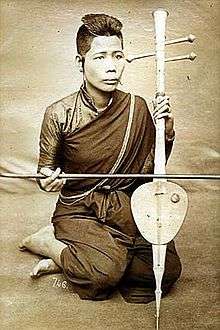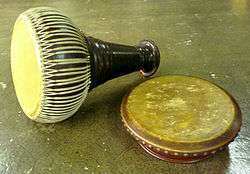Saw sam sai
 Three-stringed tro Khmer fiddle. Although the tro Khmer and saw sam sai are closely related and look very similar, each has its own traditions.[photo: Saw sam sai] In each, however, the shape of the sound box is meant to resemble the silhouette of an elephant's head, with the leg below to resembling the trunk. | |
| Classification | |
|---|---|
| Related instruments | |
The saw sam sai (Thai: ซอสามสาย, pronounced [sɔː sǎːm sǎːj], RTGS: so sam sai, also spelled saw samsai, and occasionally called simply sam sai; literally "three stringed fiddle") is a traditional bowed string instrument of Thailand.[1] Its body is made from a coconut that has "three lobes".[1] The coconut is cut in half vertically and the shape is remeniscent of the silouette of an elephant's head (from the front, not side). The coconut bowl is covered on one end with animal skin, and it has three silk strings.[1] Typically, the player glues a jewel onto the skin before playing, to reduce the skin's resonance.
The saw sam sai is in the saw family of Thai fiddles, which also includes the saw u and saw duang.
It is the hardest to play among the 4 types of Thai Saw: saw u, saw duang, and salo. This is because the bow is not attached, and one must "break" their wrist back and forth to change strings- not tilting the bow. Because of this, it is frequently used as a prop in pictures to show knowledge or a high social status. It is related to a very similar Cambodian instrument called tro Khmer.
History
Saw Sam Sai is one of Thai traditional instruments was invented in the “Sukhothai” period.[1] Thai people in Sukhothai called it “Saw – Poong – Tor.” During the reign of Phra Phutthaloetla Naphalai (Rama II of Siam), farmers who grew the special 3-lobed coconut that resembled an elephant's head were given relief from taxation, to keep the coconut from becoming extinct.[1] A transaction made in 1814 by Rama II, has been recorded, saved in an archive. The message was written from Jao Phraya Akkaramahasenabadee to Phraya Nakhornsrithammarat period. The content in archive is “We need a lot of goat skins for making a lot of Saw and Klong Khaek. Collect goat skins from Bangkok and Nakhornsithammarat, then tell the price, send to us and we will give a money.”[1]
Construction
The body or soundbox of the saw sam sai is made from coconut shell (Ka – loke ) covered with cow or goat skin. Goat is prefered for the better sound.[2] The three stings pass over a bridge on the skin soundboard to the spike below the sound bowl head.[2] They pass into a hole in the spike and are secured after coming out the other side. Overall length of the instrument is approximately 1.15 meters.[2] The instrument's body or handle, a stick (Tuan), passes through Ka loke coconut shell; it can be made either from wood or ivory.[2]/ The middle of tuan is covered by metal, the bottom has a needle to keep the instrument on the floor, the top has three knobs for tuning.[2] A string called “Nhuad Phram” is made from silk.[2]
References
- 1 2 3 4 5 6 "ประวัติซอสามสาย [History of the Saw sam sai]". sites.google.com. Retrieved 12 October 2018.
- 1 2 3 4 5 6 "ซอสามสาย [History of the saw sam sai]". adirek.com. Archived from the original on 13 June 2010. Retrieved 13 October 2018.
External links
See also
